Analyzing Discussions: Technology, Religion, and Artistic Work
VerifiedAdded on 2022/09/27
|5
|768
|17
Discussion Board Post
AI Summary
This assignment presents a student's responses to discussion prompts concerning the relationship between technology, religion, and artistic work. The student explores how technology and religion are intertwined, referencing Harari's perspective and considering whether technology can alter religious beliefs or serve spiritual needs. Furthermore, the assignment delves into the impact of technology, such as social media and tools like Photoshop, on artistic creation, analyzing whether technology enhances or diminishes the value of artwork. The student also considers the role of technology in art, referencing the use of 3D printing and digital art tools. The assignment draws on scholarly sources to support arguments, offering a comprehensive analysis of these complex relationships.
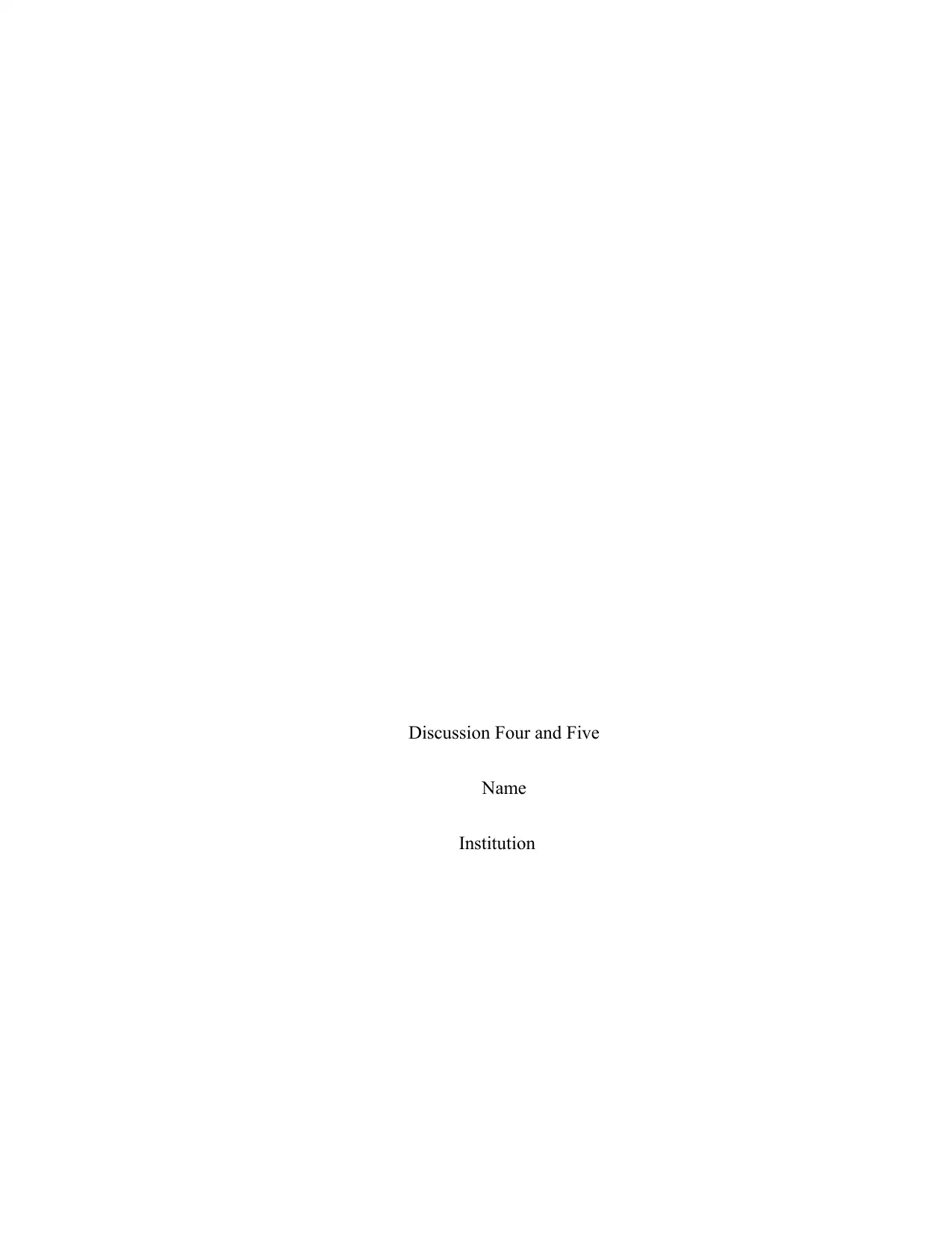
Discussion Four and Five
Name
Institution
Name
Institution
Paraphrase This Document
Need a fresh take? Get an instant paraphrase of this document with our AI Paraphraser
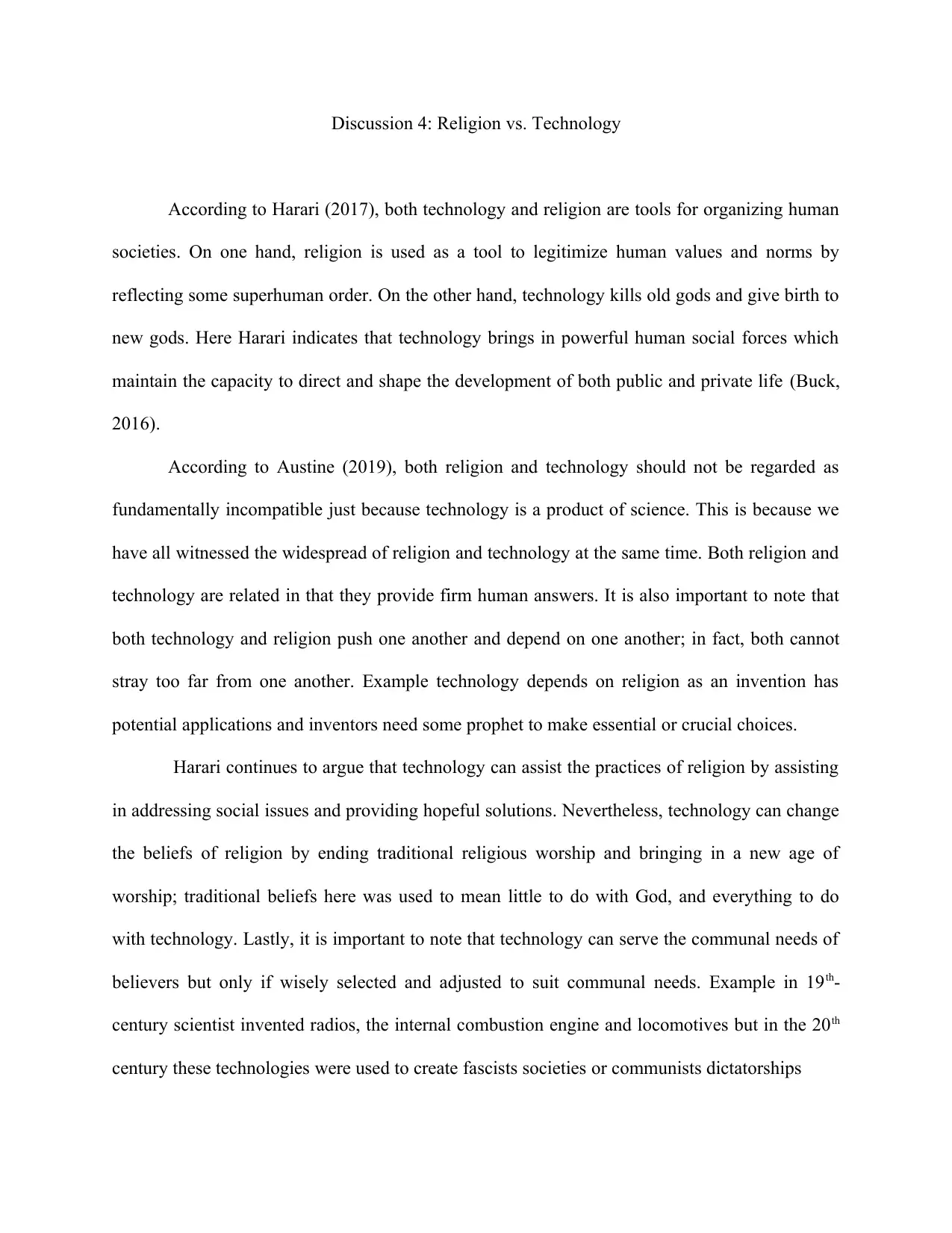
Discussion 4: Religion vs. Technology
According to Harari (2017), both technology and religion are tools for organizing human
societies. On one hand, religion is used as a tool to legitimize human values and norms by
reflecting some superhuman order. On the other hand, technology kills old gods and give birth to
new gods. Here Harari indicates that technology brings in powerful human social forces which
maintain the capacity to direct and shape the development of both public and private life (Buck,
2016).
According to Austine (2019), both religion and technology should not be regarded as
fundamentally incompatible just because technology is a product of science. This is because we
have all witnessed the widespread of religion and technology at the same time. Both religion and
technology are related in that they provide firm human answers. It is also important to note that
both technology and religion push one another and depend on one another; in fact, both cannot
stray too far from one another. Example technology depends on religion as an invention has
potential applications and inventors need some prophet to make essential or crucial choices.
Harari continues to argue that technology can assist the practices of religion by assisting
in addressing social issues and providing hopeful solutions. Nevertheless, technology can change
the beliefs of religion by ending traditional religious worship and bringing in a new age of
worship; traditional beliefs here was used to mean little to do with God, and everything to do
with technology. Lastly, it is important to note that technology can serve the communal needs of
believers but only if wisely selected and adjusted to suit communal needs. Example in 19th-
century scientist invented radios, the internal combustion engine and locomotives but in the 20th
century these technologies were used to create fascists societies or communists dictatorships
According to Harari (2017), both technology and religion are tools for organizing human
societies. On one hand, religion is used as a tool to legitimize human values and norms by
reflecting some superhuman order. On the other hand, technology kills old gods and give birth to
new gods. Here Harari indicates that technology brings in powerful human social forces which
maintain the capacity to direct and shape the development of both public and private life (Buck,
2016).
According to Austine (2019), both religion and technology should not be regarded as
fundamentally incompatible just because technology is a product of science. This is because we
have all witnessed the widespread of religion and technology at the same time. Both religion and
technology are related in that they provide firm human answers. It is also important to note that
both technology and religion push one another and depend on one another; in fact, both cannot
stray too far from one another. Example technology depends on religion as an invention has
potential applications and inventors need some prophet to make essential or crucial choices.
Harari continues to argue that technology can assist the practices of religion by assisting
in addressing social issues and providing hopeful solutions. Nevertheless, technology can change
the beliefs of religion by ending traditional religious worship and bringing in a new age of
worship; traditional beliefs here was used to mean little to do with God, and everything to do
with technology. Lastly, it is important to note that technology can serve the communal needs of
believers but only if wisely selected and adjusted to suit communal needs. Example in 19th-
century scientist invented radios, the internal combustion engine and locomotives but in the 20th
century these technologies were used to create fascists societies or communists dictatorships
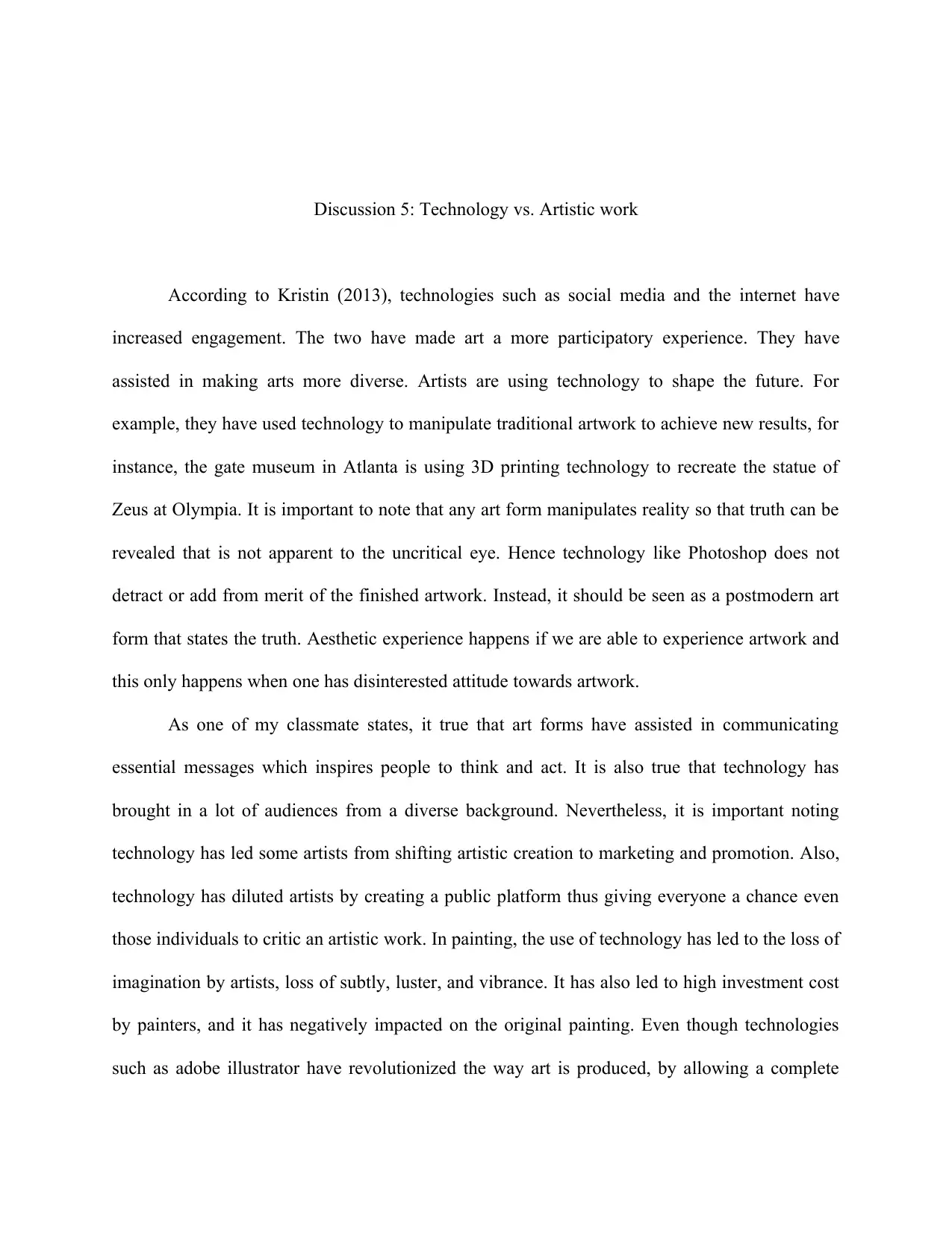
Discussion 5: Technology vs. Artistic work
According to Kristin (2013), technologies such as social media and the internet have
increased engagement. The two have made art a more participatory experience. They have
assisted in making arts more diverse. Artists are using technology to shape the future. For
example, they have used technology to manipulate traditional artwork to achieve new results, for
instance, the gate museum in Atlanta is using 3D printing technology to recreate the statue of
Zeus at Olympia. It is important to note that any art form manipulates reality so that truth can be
revealed that is not apparent to the uncritical eye. Hence technology like Photoshop does not
detract or add from merit of the finished artwork. Instead, it should be seen as a postmodern art
form that states the truth. Aesthetic experience happens if we are able to experience artwork and
this only happens when one has disinterested attitude towards artwork.
As one of my classmate states, it true that art forms have assisted in communicating
essential messages which inspires people to think and act. It is also true that technology has
brought in a lot of audiences from a diverse background. Nevertheless, it is important noting
technology has led some artists from shifting artistic creation to marketing and promotion. Also,
technology has diluted artists by creating a public platform thus giving everyone a chance even
those individuals to critic an artistic work. In painting, the use of technology has led to the loss of
imagination by artists, loss of subtly, luster, and vibrance. It has also led to high investment cost
by painters, and it has negatively impacted on the original painting. Even though technologies
such as adobe illustrator have revolutionized the way art is produced, by allowing a complete
According to Kristin (2013), technologies such as social media and the internet have
increased engagement. The two have made art a more participatory experience. They have
assisted in making arts more diverse. Artists are using technology to shape the future. For
example, they have used technology to manipulate traditional artwork to achieve new results, for
instance, the gate museum in Atlanta is using 3D printing technology to recreate the statue of
Zeus at Olympia. It is important to note that any art form manipulates reality so that truth can be
revealed that is not apparent to the uncritical eye. Hence technology like Photoshop does not
detract or add from merit of the finished artwork. Instead, it should be seen as a postmodern art
form that states the truth. Aesthetic experience happens if we are able to experience artwork and
this only happens when one has disinterested attitude towards artwork.
As one of my classmate states, it true that art forms have assisted in communicating
essential messages which inspires people to think and act. It is also true that technology has
brought in a lot of audiences from a diverse background. Nevertheless, it is important noting
technology has led some artists from shifting artistic creation to marketing and promotion. Also,
technology has diluted artists by creating a public platform thus giving everyone a chance even
those individuals to critic an artistic work. In painting, the use of technology has led to the loss of
imagination by artists, loss of subtly, luster, and vibrance. It has also led to high investment cost
by painters, and it has negatively impacted on the original painting. Even though technologies
such as adobe illustrator have revolutionized the way art is produced, by allowing a complete
⊘ This is a preview!⊘
Do you want full access?
Subscribe today to unlock all pages.

Trusted by 1+ million students worldwide
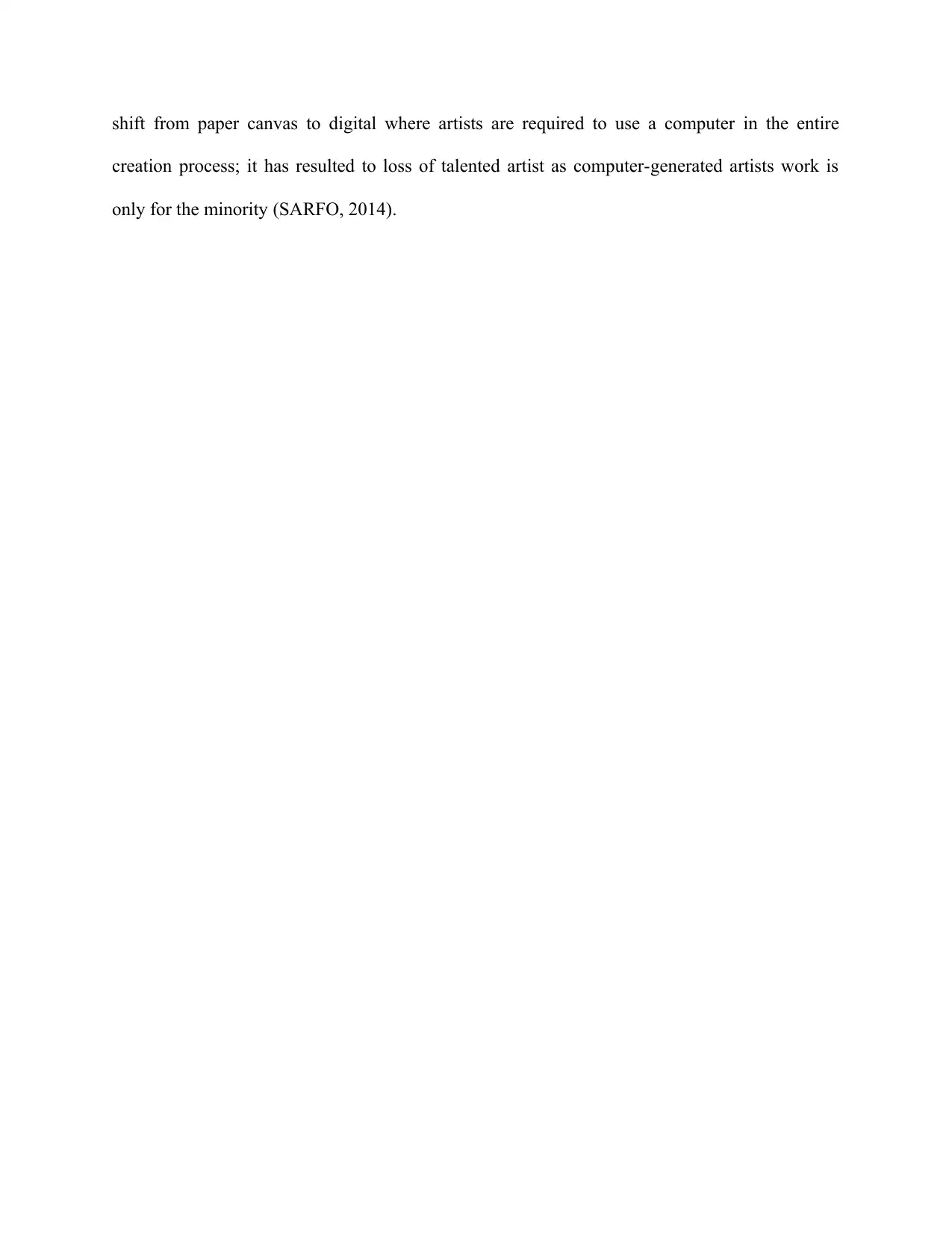
shift from paper canvas to digital where artists are required to use a computer in the entire
creation process; it has resulted to loss of talented artist as computer-generated artists work is
only for the minority (SARFO, 2014).
creation process; it has resulted to loss of talented artist as computer-generated artists work is
only for the minority (SARFO, 2014).
Paraphrase This Document
Need a fresh take? Get an instant paraphrase of this document with our AI Paraphraser
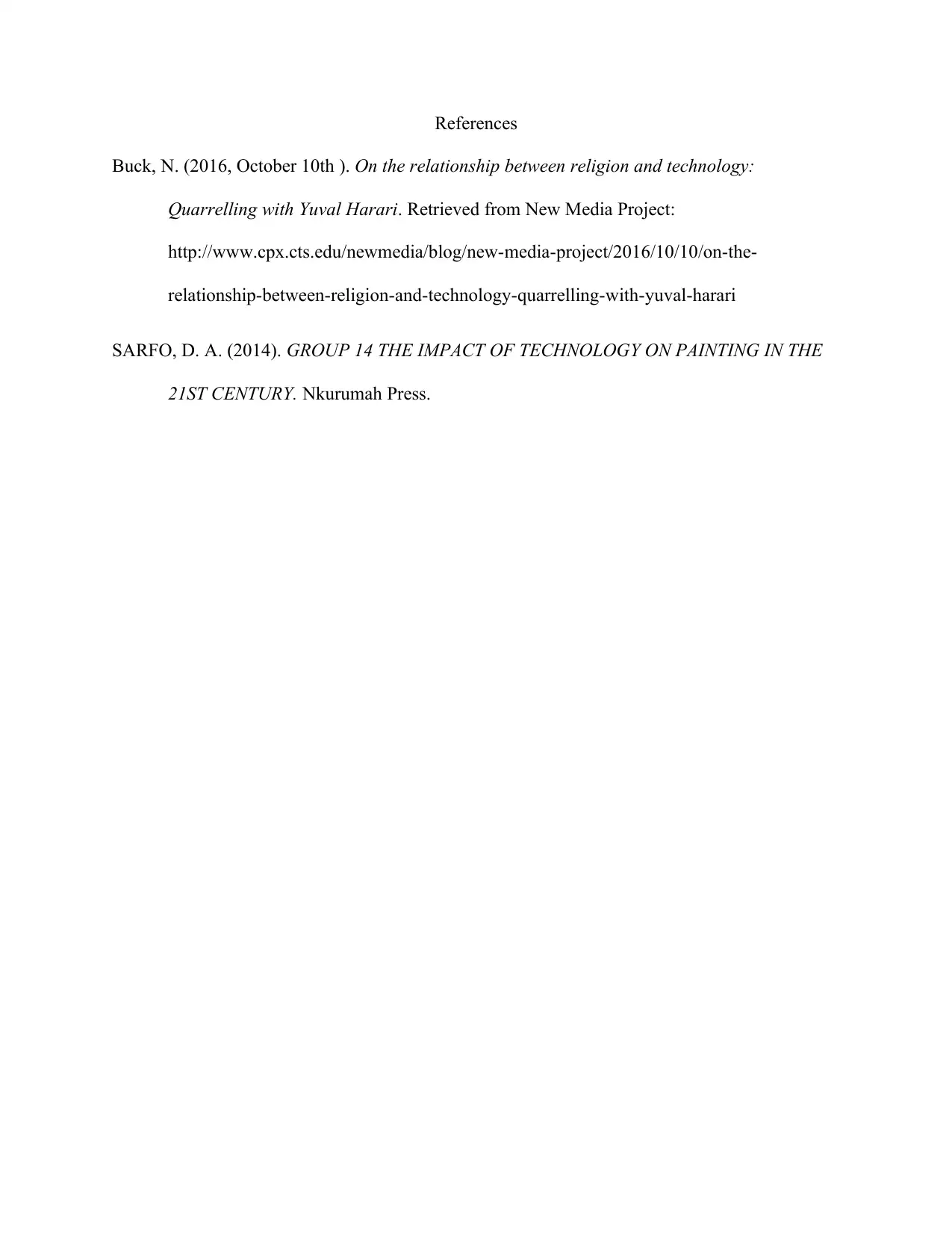
References
Buck, N. (2016, October 10th ). On the relationship between religion and technology:
Quarrelling with Yuval Harari. Retrieved from New Media Project:
http://www.cpx.cts.edu/newmedia/blog/new-media-project/2016/10/10/on-the-
relationship-between-religion-and-technology-quarrelling-with-yuval-harari
SARFO, D. A. (2014). GROUP 14 THE IMPACT OF TECHNOLOGY ON PAINTING IN THE
21ST CENTURY. Nkurumah Press.
Buck, N. (2016, October 10th ). On the relationship between religion and technology:
Quarrelling with Yuval Harari. Retrieved from New Media Project:
http://www.cpx.cts.edu/newmedia/blog/new-media-project/2016/10/10/on-the-
relationship-between-religion-and-technology-quarrelling-with-yuval-harari
SARFO, D. A. (2014). GROUP 14 THE IMPACT OF TECHNOLOGY ON PAINTING IN THE
21ST CENTURY. Nkurumah Press.
1 out of 5
Related Documents
Your All-in-One AI-Powered Toolkit for Academic Success.
+13062052269
info@desklib.com
Available 24*7 on WhatsApp / Email
![[object Object]](/_next/static/media/star-bottom.7253800d.svg)
Unlock your academic potential
Copyright © 2020–2025 A2Z Services. All Rights Reserved. Developed and managed by ZUCOL.





